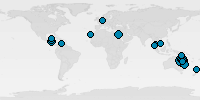
Before transformed into one of the best diving sites near San Diego, the Ruby E was a coast guard cutter, rum runner and fishing vessel.
| Name Dive Site: | Ruby E |
| Depth: | 65-91ft (20-28m) |
| Inserted/Added by: | ken, © Author: Channel Islands Dive |
| Rated: | Rated 2.3, 3 votes |
| Specifications: |   |
| GPS: | N32°46'02", W117°16'36" |
Send us your images for this dive site[Add Image][Add Movie]
The Ruby E began her life as the Coast Guard Cutter named Cyane (WPC-105) and was built in 1934 in Seattle Washington. She was 165' long and designed to intercept "rum runners" during prohibition years. She was built to travel fast to reach and pursue the rum runners that were operating along the entire West Coast. The only problem with this was, she was completed after prohibition ended and was now not needed for her original purpose so the Coast Guard found a new purpose for her off the Alaskan coast where she served for 16 years, until she was decommissioned in 1950. Her career included Bering Sea and Alaskan Anti-Submarine Patrols during WWII.
In 1954, she was sold, renamed the Can Am and converted into a fish-processing vessel with several modifications and afterwards she was sent to fish the waters off Central and South America. Sometime afterwards she was reportedly impounded by customs officers in South America for drug smuggling.
Sold again, the Can Am was renamed the Ruby E and outfitted as a salvage vessel. She was seized as bank repossession because the owners could not repay their bank loans and she sat in San Diego harbor until purchased by the San Diego Tug and Barge Company. After being scrapped the Ruby E was donated to be sunk in wreck alley as a dive attraction and artificial reef off Mission Bay. After being environmentally cleaned and made accessible to divers by cutting holes in various parts of the ship she was ready to take her place on the ocean floor in Wreck Alley.
The morning of July 18, 1989 she was towed to a planned location off Mission Beach and anchored. The sea cocks were opened and it was hoped she would fill up with water and sink. The spectators watching the sinking waited and watched. By noon, the ship was still afloat with only a slight starboard list. Unknown to planners, two secret compartments were hidden in the bulkheads fore and aft of the engine room. These sealed compartments were used to hide drugs during its smuggling days and now prevented her from sinking.
Local lifeguards brought several large pumps on board to speed up the flooding. It took awhile and finally, at 3:30 PM the lifeguards were forced to abandon the Ruby E as she began to sink. With her stern leading the plunge, she rolled briefly onto her starboard side as seawater approached her amidships. Suddenly, her bow and forward compartment shot straight up into the sky, before slowly sinking to the bottom where she has become an excellent addition to Wreck Alley.
Diving the Ruby E can be awesome on those perfect days when the visibility is at its best. For the most part she sits upright in 85' of water on a sand bottom. She is intact and with her being made diver friendly she is easy to dive. For the experienced and certified wreck divers there are areas that can be penetrated. Visibility can be 10'-70' and on average is 15'-20'. Water temperature is usually 50's to 60's depending on the time of year. Most of the wreck is covered with growth, such as strawberry anemones and a small kelp bed on top of the wheelhouse.
More about California wreck diving, please visit the California Wreck Divers (CWD) website along with another excellent resource, the book Shipwrecks of Southern California by Bonnie J. Cardone and Patrick Smith.
[Add Message]Messages from readers:
[Add Divelog]Divelogs from members:

